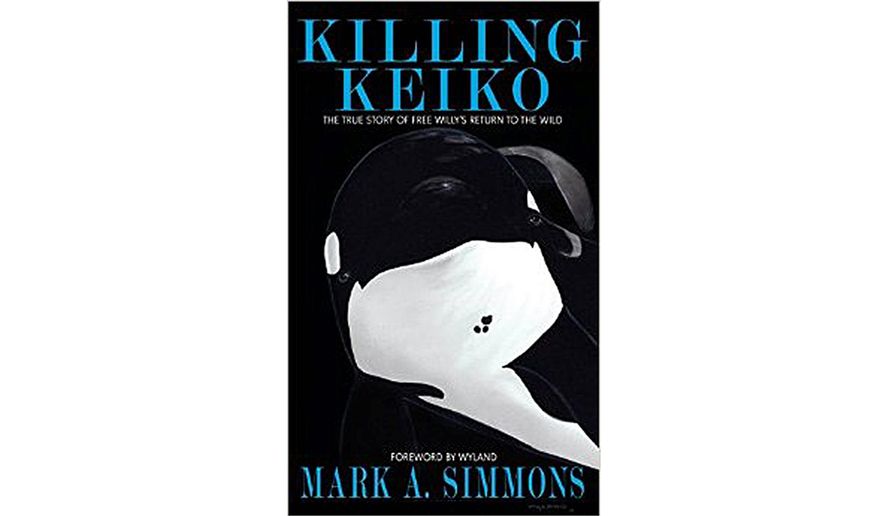OPINION:
KILLING KEIKO: THE TRUE STORY OF FREE WILLY’S RETURN TO THE WILD
By Mark Simmons
Callinectes Press, $15.95, 408 pages
The film “Free Willy” captured the imagination of viewers in 1993 with a story detailing a young boy’s desire to free a killer whale named “Willy” from captivity in an amusement park. At the end of the film, Willy swims off to freedom. But the inspirational film bears little resemblance to reality, according to Mark Simmons, author of “Killing Keiko: The True Story of Free Willy’s Return to the Wild.”
Mr. Simmons gives his account of the effort to “free” the whale that played Willy in the movie — a real-life killer whale named Keiko. Unlike Willy, the whale in Mr. Simmons’ book didn’t actually want to be “freed.”
Nonetheless, the “free Keiko” effort started in 1994 with the formation of The Free Willy Keiko Foundation (FWKF), launched with a Warner Bros. grant to the Earth Island Institute in 1994. In 1995, the Humane Society of the United States (HSUS) joined as a sponsor, and the Mexico City amusement park that owned Keiko donated the whale to the FWKF.
Keiko was eventually moved to an Oregon aquarium in 1996 and then to Iceland in 1998 for pre-release rehabilitation. Equipped with a tracking device, Keiko swam from Iceland to Norway in August 2002, and Keiko project trainers eventually moved their operation to Norway until Keiko’s death in 2003.
Mr. Simmons and his business partner Robin Friday — both former SeaWorld orca trainers — had joined the effort in April 1999 to rehabilitate Keiko in Iceland. They joined despite serious reservations about the ideological, animal-rights agenda of members on the FWKF board. That agenda eschewed keeping animals in captivity, making a profit off of them and even domestication.
“We thought, perhaps foolishly and maybe idealistically, that we could collaborate,” Mr. Simmons notes. Success required careful conditioning to help Keiko live and feed on his own and eventually connect with wild whales — goals that Mr. Simmons and Mr. Friday set out to achieve.
According to the website of the “Keiko Project,” — a page hosted by the FWKF and HSUS — Keiko progressed well over these years, eventually learning to eat live fish and interact with wild whales, something Mr. Simmons maintains never happened. Reports that Keiko was “often seen competing with wild whales for food” were “spoon fed to the media,” by Keiko project members although these claims “perverted actual events,” says Mr. Simmons.
Instead, Keiko was perpetually deprived of the things he needed: human companionship and nutrition. He also periodically suffered from a respiratory illness that required antibiotics, raising the question as to whether he could survive in the wild even if he wanted to go free.
In June of 2000, project leaders botched the first attempt to introduce Keiko to wild whales, maintains Mr. Simmons, forcing a surprise interaction amid a media circus of motorboats, helicopters and camera crews. The project board was more interested in “getting the shot” for a documentary than doing the right thing for Keiko.
A quick and forced surprised interaction with a wild whale pod startled Keiko, who disappeared for hours, only to then reappear exhausted, red-eyed and traumatized. “Keiko’s first exposure should have been a process — a series of approximations, slow and calm, positive encounters. Again, this ill-conceived Hollywood version of release being a singular ’event’ derailed the path that might have ensured his survival,” lamented Mr. Simmons.
Upon returning to the base, Mr. Simmons and Mr. Friday demanded that the leadership allow more private and slower introduction methods, to which the leadership refused, and radical animal rights activists on the board prevailed. “They protested animal captivity, likening it to abuse and genocide. They saw themselves as great protectors; their mission without reproach, but they were the worst offenders,” explains Mr. Simmons.
Mr. Simmons and Mr. Friday resigned, and Mr. Simmons communicated with those who followed to complete his account. The project workers continued making myriad trips out to sea with Keiko following their boat to meet wild whale pods. Every time, Mr. Simmons says, Keiko chose to return to the boat and then back to home base with the crew.
It was only after the workers abandoned Keiko at sea in August 2002 because of an approaching storm that Keiko did not return. The hope was that he had joined a pod of whales, but instead he showed up alone off the coast of Norway on Aug. 30, 2002.
Children swam out to play with the whale, and others from the community flocked to the sight. “Keiko could not have been more entertained, swimming from hand to hand and boat to boat. Keiko was back in his human family and seemed perfectly content to remain so,” writes Mr. Simmons. But Keiko was again isolated from humans when two members of the Keiko Project moved him to a private cove on Norway’s coast for continued “rehabilitation.”
Keiko succumbed to a respiratory illness in 2003, which the Keiko Project describes as a death due to “natural causes.” But Mr. Simmons maintains that project staff lacked expertise and did not provide proper care, such as sufficient food and medicine. “Keiko did not die a justified death, nor did he die at a natural age. He was killed,” concludes Mr. Simmons.
Mr. Simmons’ account stands in stark contrast to that of official Keiko Project claims. But before you render judgment, read his book, which offers a compelling, firsthand perspective.
• Angela Logomasini is a senior fellow at the Competitive Enterprise Institute.




Please read our comment policy before commenting.